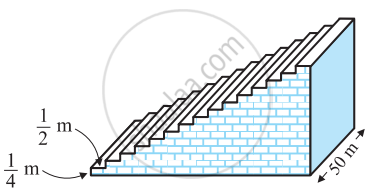Advertisements
Advertisements
प्रश्न
Kanika was given her pocket money on Jan 1st, 2008. She puts Rs 1 on Day 1, Rs 2 on Day 2, Rs 3 on Day 3, and continued doing so till the end of the month, from this money into her piggy bank. She also spent Rs 204 of her pocket money, and found that at the end of the month she still had Rs 100 with her. How much was her pocket money for the month?
उत्तर
Let her pocket money be ₹ x
Now, she puts 11 on day 1, ₹ 2 on day 2, ₹ 3 on day 3 and so on till the end of the month, from this money into her piggy bank.
i.e., 1 + 2 + 3 + 4 + ... + 31
Which form an AP in which terms are 31 and first term (a) = 1,
Common difference (d) = 2 – 1 = 1
∴ Sum of first 31 terms is S31
Sum of n terms,
Sn = `n/2[2a + (n - 1)d]`
∴ S31 = `31/2[2 xx 1 + (31 - 1) xx 1]`
= `31/2(2 + 30)`
= `(31 xx 32)/2`
= 31 × 16
= 496
So, Kanika takes ₹ 496 till the end of the month from this money.
Also, she spent ₹ 204 of her pocket money and found that at the end of the month she still has ₹ 100 with her.
Now, according to the condition,
(x – 496) – 204 = 100
⇒ x – 700 = 100
∴ x = ₹ 800
Hence, ₹ 800 was her pocket money for the month.
APPEARS IN
संबंधित प्रश्न
A small terrace at a football field comprises 15 steps, each of which is 50 m long and built of solid concrete. Each step has a rise of `1/4` m and a tread of `1/2` m (See figure). Calculate the total volume of concrete required to build the terrace.
[Hint: Volume of concrete required to build the first step = `1/4 xx 1/2 xx 50 m^3`]

If 4 times the 4th term of an AP is equal to 18 times its 18th term then find its 22nd term.
What is the 5th term form the end of the AP 2, 7, 12, …., 47?
Find the 25th term of the AP \[- 5, \frac{- 5}{2}, 0, \frac{5}{2}, . . .\]
If the sum of first n terms of an A.P. is \[\frac{1}{2}\] (3n2 + 7n), then find its nth term. Hence write its 20th term.
If the first, second and last term of an A.P. are a, b and 2a respectively, its sum is
Q.14
In an A.P. (with usual notations) : given a = 8, an = 62, Sn = 210, find n and d
Find the sum of all the 11 terms of an AP whose middle most term is 30.
The ratio of the 11th term to the 18th term of an AP is 2 : 3. Find the ratio of the 5th term to the 21st term, and also the ratio of the sum of the first five terms to the sum of the first 21 terms.
